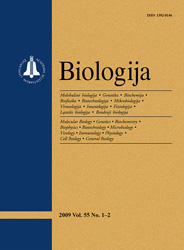Biologija / Biology
 ISSN 1392-0146 ISSN 2029-0578 (online) |
2007 m. Nr. 1 Are TGFA, TGFB3, GABRB3, RARA and BCL3 loci
associated with nonsyndromic orofacial clefts?
A Lithuanian study
Nonsyndromic orofacial clefting (NS-OFC) is a common complex multifactorial trait with a considerable genetic component and a number of candidate genes suggested by different approaches, but the question of the contribution of their sequence variation to the risk of NS-OFC is still open. A set of 21 biallelic and microsatellite DNA markers in the strong candidate loci TGFA, TGFB3, GABRB3, RARA, and BCL3 were analysed for allelic association with the NS-OFC phenotype in 112 nuclear families (child affected with NSOFC poband + both parents) from Lithuania using the transmission disequilibrium test (TDT). Association was found between the TGFA gene marker rs2166975 and nonsyndromic clef palate (CPO) phenotype (P = 0.0455 [df 1]) as well as between the D2S292 marker and isolated cleft lip with or without cleft palate (CL/P) phenotype in allele-wise TDT (P = 0.0053 [df 9]) and genotype-wise TDT (P = 0.0206 [df 24]). A weak association (P = 0.0850 [df 3]) of the BCL3 marker (BCL3 gene) with the risk of CPO was also shown. Thus, our initial results support the contribution of TGFA locus allelic variation in the etiology of CL/P in the population of Lithuania, but do not point to TGFA as a major causal gene. Different roles for the TGFA and BCL3 genes in the susceptibility to NS-OFC phenotypes are suggested.
Keywords: allelic association, candidate genes, nonsyndromic orofacial clefts, transmission disequilibrium test, TDT |
Issues:
2011 - Vol.57 No. 1, No. 2, No. 3 2010 - Vol.56 No. 1-4 2009 - Vol.55 No. 1-2, No. 3-4 2008 - Vol.54 No. 1, No. 2, No. 3, No. 4 2007 - Vol.53 No. 1, No. 2, No. 3, No. 4 2006 No. 1, No. 2, No. 3, No. 4 2005 No. 1, No. 2, No. 3, No. 4 2004 No. 1, No. 2, No. 3, No. 4 2003 No. 1, No. 2, No. 3, No. 4 2002 No. 1, No. 2, No. 3, No. 4 2001 No. 1, No. 2, No. 3, No. 4 |